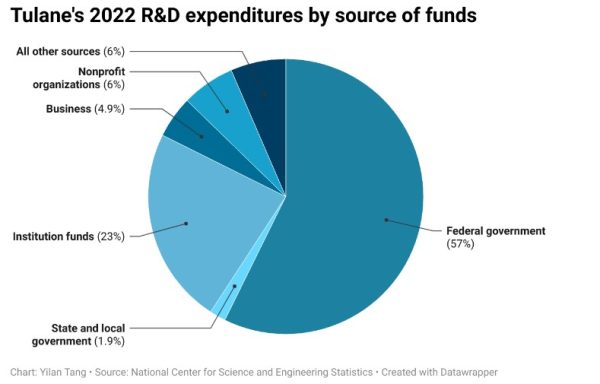In an era of increasing technological innovation, universities are seizing the opportunity to facilitate technological advancements — a process made possible by research and development funding, also known as R&D.
Currently, R&D funding is on the rise at Tulane University. Investing in R&D drives innovation and elevates the university’s reputation within scientific fields. Additionally, it contributes to research initiatives, technological innovation and the general pursuit of new findings. At Tulane, this translates to graduate student training, anti-aging research, the mapping of an ancient civilization and state-of-the-art facilities like Steven and Jann Paul Hall for Science and Engineering. Currently ranked No. 121 in total R&D expenditure nationwide, Tulane places itself squarely in the top 20% of all universities surveyed.
Between 2010 to 2022, Tulane’s R&D expenditures rose significantly, but there was a 3.27% decrease from 2014 to 2015. This decrease in expenditures was not shared by most other universities. Though the reason for this drop in spending is unclear, since 2015, Tulane’s spending continues to grow. When compared to R&D expenditures of other universities, Tulane has consistently ranked between No. 115 and No. 121 out of around 637 colleges and universities for the past 10 years.
R&D funding comes from a variety of sources. In 2022, the federal government provided roughly 57% of Tulane’s R&D funding. As a member of the Association of American Universities and classified as a “R1” research university, Tulane garners significant research funding from federal sources. One example is Tulane’s portion of a $160 million grant from the National Science Foundation. As a part of the coalition awarded this grant, Tulane will work towards a project to sustain Louisiana’s energy industry with other universities, companies and organizations.
The second largest source of funds is Tulane itself, accounting for 23%. These funds come from tuition, donations to the university and Tulane’s endowment. A variety of other sources, including state and local government, private businesses and nonprofit organizations, supply the remaining 20% of funds. For example, the Tulane University School of Social Work was awarded a $750,000 grant by the Walmart Foundation in 2022 to develop disaster resilience programs. The distribution of funding from these other sources is illustrated below.

As defined by the National Science Foundation, “R&D covers three types of activities: basic research, applied research and experimental development.” From cancer imaging research to analysis of intimate partner violence, R&D expenditure enables Tulane to generate innovative new technologies and evaluate issues to develop solutions. Tulane fundamentally integrates research and innovation into its institutional framework, a point of pride for the university. With the mission of creating, communicating and conserving knowledge, R&D remains a critical component of Tulane’s existence as a research institution.



Leave a Comment